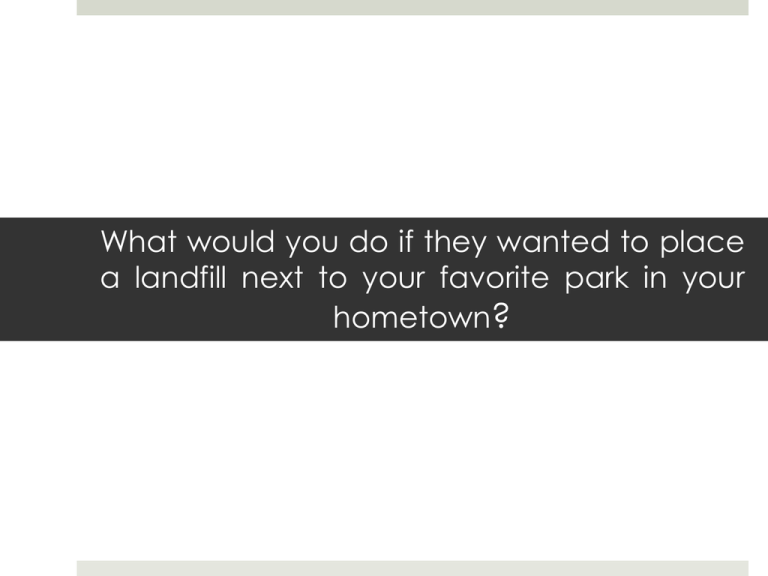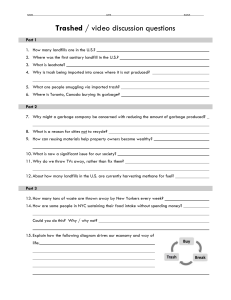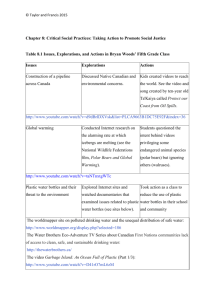Environmental Racism
advertisement

What would you do if they wanted to place a landfill next to your favorite park in your hometown? Energy Resources & Anthropogenic Effects on the Environment The term anthropogenic refers to an effect that is caused by human activity. Today we will focus on how our consumer, “throw away” life style has detrimentally effected the environment and we will look at possible solutions to preventing more harm to the environment. 1955- Introduction of “Throw Away Living” Life Magazine introduced “new” products that are very familiar to us and we use every day. Some of the “cool new” items that were introduced in 1955 was: Paper Plates Paper Napkins Garbage Bags Petroleum to Plastic Plastic products are used every day and have increased the ease of living. However, plastic is made from petroleum, which is a type of fossil fuel. Fossil Fuels Are natural fuels such as coal or gas, formed in the geological past from the remains of living organisms. They are used for the production of many items from plastic to electricity. They release harmful pollution and are not always energy efficient. The biggest problem with fossil fuels is that they are NON RENEWABLE. Non- Renewable Resources Are natural resources which cannot be reproduced, grown or generated. Once they are depleted (gone) there are no more available for future needs. Unintended Consequences An unexpected effect that can cause serious harm to an environment or health of an individual. Again, lets focus on plastic…. It is not biodegradable, which means when you liter plastic, it does not break down. It may not appear to be serious when you throw a plastic bottle on the ground, however, there are many unintended consequences associated with doing such thing. Lets look at the following case study… Garbage Island You will watch two videos about the “Great Pacific Garbage Dump” that is located in the Pacific Ocean and bigger than the state of Texas. You will answer questions after these videos, so pay attention and take notes on things that shock you or that you found to be interesting. Stop and Jot: Garbage Island Discussion Take out paper and answer the following questions with 3-4 sentences. This will be collected! 1. After viewing these videos, how did you feel? 2. Why do you think little is being done to prevent or stop this issue? 3. What do you think could be done to stop this issue from getting worse? 4. Do you think more awareness of this issue would bring about bigger changes? 5. What does living environmentally consciously mean to you? 6. Will these films inspire you to take preventative measures against littering? Solution to Pollution? Which seems like the best practice of disposing waste that will have the least harmful effect on the environment?? Explain why you selected the answer that you did. 1. Put landfills far away from people and major cities. 2. Send garbage over seas to other countries. 3. Burn the garbage, because this would save space… 4. Use recyclable materials and renewable energy. Renewable Sources Wind Power Geothermal Solar Hydrothermal Create Frayer Model For Each Type of Energy We Are About to Discuss Write the Type of Energy in the Middle Follow the directions on your worksheet to fill in the other boxes Wind Power Pros Cons Wind is free Can be damaged in bad weather (ex: lightening) The wind industry internationally is able to provide at least 12% of the world’s future electricity needs by 2020, even if current consumption doubles. Potential for jobs (building them) Creates a noise that some find disturbing. Birds fly into them. Some people claim they are an “eye sore” Solar Energy Pros Cons No pollution Can be very expensive to install Panels can be installed in many places (ex: roofs or telephone poles) Bad weather will prevent efficient usage (ex: cloudy/rain) Some places offer tax breaks for the use of solar panels Only works when the sun is out Silent and no moving parts Some people do not like how they look Geothermal Energy Pros Cons Has practically unlimited potential Initial cost is high Can save a lot of money Getting this energy from the ground has reportedly caused Earthquakes in some areas Can be used for a wide array of different purposes Requires a large plot of land to get the energy It is reliable Hydropower Energy Pros Cons Fueled by water, so it doesn’t pollute the air Fish populations can be impacted if fish cannot migrate upstream Creates reservoirs that offer a variety of recreational opportunities, notably fishing, swimming, and boating. Have a long life span Can impact water quality and flow Can be impacted by drought. What does it stand for? “Not In My Backyard” A common response from citizens when an unfavorable structure wants to be placed in their town. For example, people may protest a landfill being placed in their town because no one wants the eyesore, pollution, truck traffic, or smells associated with one. NIMBY could be used positively (to bring attention to a health risk) or negatively (for personal, selfish reasons). Uranium Mining in the West Is this an example of positive or negative usage of a NIMBY protest? Wind Turbines in Cape Cod Is this an example of using NIMBY for personal gain? Do you think it’s selfish to think of how a structure will affect you as an individual? If you were a situation similar to the examples, would you be able to realize the bigger picture and see the full benefits associated with the situation? Why/why not? Environmental Racism What is Environmental Racism? The disproportionate impact of environmental contamination Refers to the decisions to put hazardous waste facilities and other unwanted land uses in predominantly poor and people-of-color communities Also, it includes racial discrimination in formulating and carrying out environmental policy Barnes-Davies, Rebecca. "Environmental Racism." National Council of Churches Eco-Justice Working Group. Web. <http://www.umc-gbcs.org/atf/cf/ %7B689FEA4C-8849-4C05-A89E-C9BC7FFFF64C%7D/Environmental%20Racism%20study%20guide.pdf>. Environmental Racism in Today’s Society Do you believe environmental racism is evident in modern society? Does it Still Exist Today? Modern Day Examples Ramifications 6 out of 7 bus depots are located around Harlem, a predominantly AfricanAmerican community High rates of illness and deaths due to asthma Native American land affected by the many uranium mines surrounding the area Atgeld Garden is low-income housing is located near sewage treatment plants, landfills, power plants, or toxic dumps in Chicago Land is contaminated, which caused health affects on the people, animals and drinking water Many reports of cancer, respiratory problems & birth deformities Barnes-Davies, Rebecca. "Environmental Racism." National Council of Churches Eco-Justice Working Group. Web. <http://www.umc-gbcs.org/atf/cf/ %7B689FEA4C-8849-4C05-A89E-C9BC7FFFF64C%7D/Environmental%20Racism%20study%20guide.pdf>.





